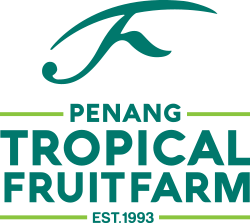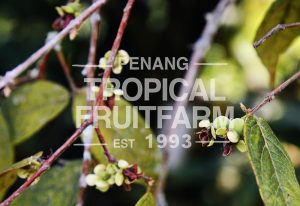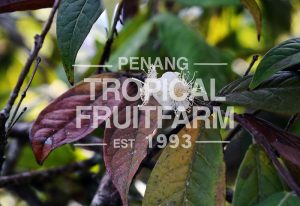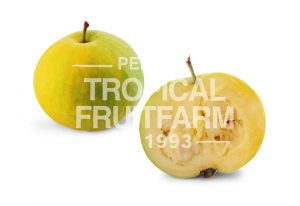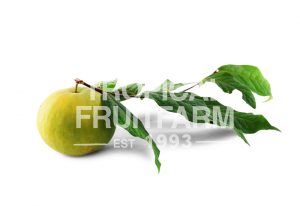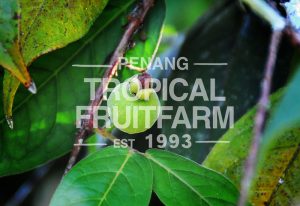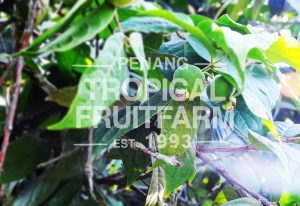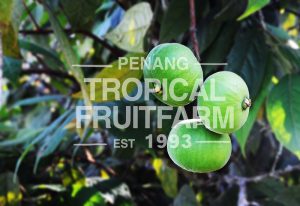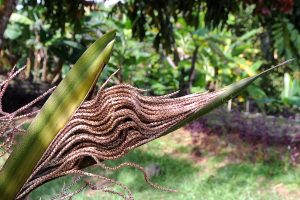| Origin | Araca boi is a fruit tree believed to have its origin in the extreme west of the Amazon basin, perhaps in the Peruvian Amazon. Its native range includes Bolivia, Brazil, Colombia and Peru. |
| Description | Araca boi is an ornamental leafy tree or shrub, 3-15m tall, of densely branched habit, stem with brown to reddish-brown, bark flaking, young branches covered with short, velvety, brown hairs that are lost at age. |
| Growth Habitat | The araca boi is a species of the humid, tropical high forest, growing from sea level to 650m altitude. In its natural habitat, the rainfall averages 2,800mm, with a mean annual temperature of 26 degress centigrade. It grows well in semi-exposed or exposed areas and it can withstand a drought of up to 2 months. |
| Foliage | Leaves are opposite, simple, without broadly elliptic, 8-19cm long, 3.5-9.5 wide, dull, dark green above, with 6-10 pairs of ingrained sidelong veins, pale green with scattered hairs below. |
| Flowers | The flowers are in compound axillary racemes. The 4 petals are white, with 75 to 150 stamens and a single pistil and a multi-locular ovary. |
| Fruits | The fruit is rounded or spherical berry, 2-10cm long and 2-12cm wide, weighing 50-750g, light green at first, turning pale or orange yellow when mature. The fruit is soft, with a thin smooth skin, enclosing a juicy thick pulp that contains approximately 12 seeds, The fruit pulp accounts for more than 60 percent of the fruit. |
| Harvest | The fruits should be harvested once a week because they mature rapidly. The fruit is harvested green mature to avoid fruit softening and bruising. |
| Soil | Araca boi prefers well drained, fertile loamy soil but will tolerate poorer clayey oxisol provided they are well drained. It also tolerates acid soil stress. |
| Pruning | Pruning of young trees are recommended looking for the formation of three four heavy branches. Also, annual pruning and general clean up should be done. |
| Fertilization | Experimental results on fertilization suggest that organic fertilizer with manure is preferable to chemical fertilizers. |
| Propagation | Plant propagation is by seeds, air-layering, grafting or budding. |
| Nutritional Properties | For 100g of fruit, there is approximately 775 mg of vitamin A, 9.84 mg of vitamin B1, 768 mg of vitamin C (which is double that of an orange). The surprisingly high protein content presumably comes from the inclusion of the seeds. The fruit has some value as a source of vitamins and minerals. Potassium seems to be an especially important nutrient for araca boi. |
| Health Benefits | Araca fruit has more Vitamin C than oranges and this boost the immune system drastically and protects the body from infections. Rich in Vitamin A and C, plus folate, and other essential nutrients, they may help prevent heart disease and stroke, control blood pressure and cholesterol, prevents some types of cancer and guard against vision lost. |
| Commercial Uses | The fruit is rarely eaten raw on its own because of its high acidity but it can be eaten fresh sprinkled with sugar. They are commonly used to make juices, soft drinks, ice-cream, smoothies, sherbets, jelly, preserves and dessert. In addition, there is a wide variety of industrialized products on the market in the from of paste, jam, crystallized fruits preserves in syrups and liqueur. Another use of this fruit tree is to rehabilitate exhausted land and also for ornamental purposes. |
| Food Suggestion | Araca Boi Hot Pepper Jelly Ingredients: - 2 cups araca boi (peeled and de-seeded) - 1 cup apple cider vinegar - 3 habanero peppers (de-seeded) - 4 cups sugar - 3 limes (juiced) Method: 1.) Put everything in a big pot and cookdown. 2.) After 30 mins, put a dab on a cold plate in the freezer. 3.) If thickens, then mixture is ready to jar. |
